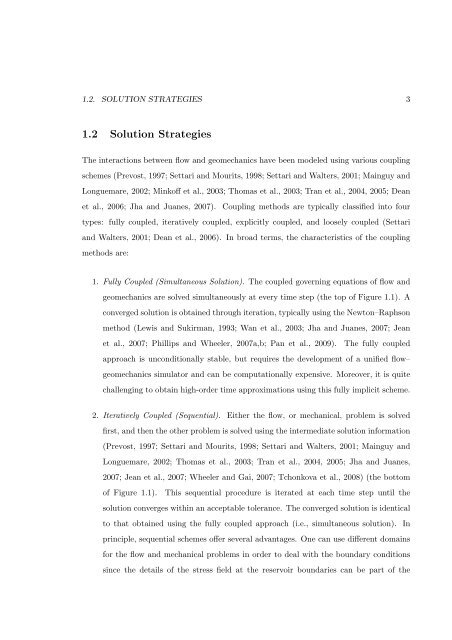Sequential Methods for Coupled Geomechanics and Multiphase Flow
Sequential Methods for Coupled Geomechanics and Multiphase Flow
Sequential Methods for Coupled Geomechanics and Multiphase Flow
Create successful ePaper yourself
Turn your PDF publications into a flip-book with our unique Google optimized e-Paper software.
1.2. SOLUTION STRATEGIES 3<br />
1.2 Solution Strategies<br />
The interactions between flow <strong>and</strong> geomechanics have been modeled using various coupling<br />
schemes (Prevost, 1997; Settari <strong>and</strong> Mourits, 1998; Settari <strong>and</strong> Walters, 2001; Mainguy <strong>and</strong><br />
Longuemare, 2002; Minkoff et al., 2003; Thomas et al., 2003; Tran et al., 2004, 2005; Dean<br />
et al., 2006; Jha <strong>and</strong> Juanes, 2007). Coupling methods are typically classified into four<br />
types: fully coupled, iteratively coupled, explicitly coupled, <strong>and</strong> loosely coupled (Settari<br />
<strong>and</strong> Walters, 2001; Dean et al., 2006). In broad terms, the characteristics of the coupling<br />
methods are:<br />
1. Fully <strong>Coupled</strong> (Simultaneous Solution). The coupled governing equations of flow <strong>and</strong><br />
geomechanics are solved simultaneously at every time step (the top of Figure 1.1). A<br />
converged solution is obtained through iteration, typically using the Newton–Raphson<br />
method (Lewis <strong>and</strong> Sukirman, 1993; Wan et al., 2003; Jha <strong>and</strong> Juanes, 2007; Jean<br />
et al., 2007; Phillips <strong>and</strong> Wheeler, 2007a,b; Pan et al., 2009). The fully coupled<br />
approach is unconditionally stable, but requires the development of a unified flow–<br />
geomechanics simulator <strong>and</strong> can be computationally expensive. Moreover, it is quite<br />
challenging to obtain high-order time approximations using this fully implicit scheme.<br />
2. Iteratively <strong>Coupled</strong> (<strong>Sequential</strong>). Either the flow, or mechanical, problem is solved<br />
first, <strong>and</strong> then the other problem is solved using the intermediate solution in<strong>for</strong>mation<br />
(Prevost, 1997; Settari <strong>and</strong> Mourits, 1998; Settari <strong>and</strong> Walters, 2001; Mainguy <strong>and</strong><br />
Longuemare, 2002; Thomas et al., 2003; Tran et al., 2004, 2005; Jha <strong>and</strong> Juanes,<br />
2007; Jean et al., 2007; Wheeler <strong>and</strong> Gai, 2007; Tchonkova et al., 2008) (the bottom<br />
of Figure 1.1). This sequential procedure is iterated at each time step until the<br />
solution converges within an acceptable tolerance. The converged solution is identical<br />
to that obtained using the fully coupled approach (i.e., simultaneous solution). In<br />
principle, sequential schemes offer several advantages. One can use different domains<br />
<strong>for</strong> the flow <strong>and</strong> mechanical problems in order to deal with the boundary conditions<br />
since the details of the stress field at the reservoir boundaries can be part of the
















